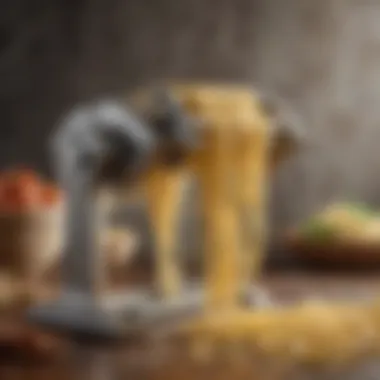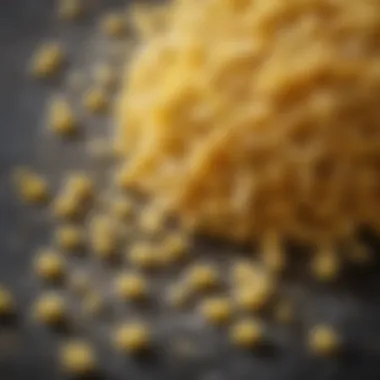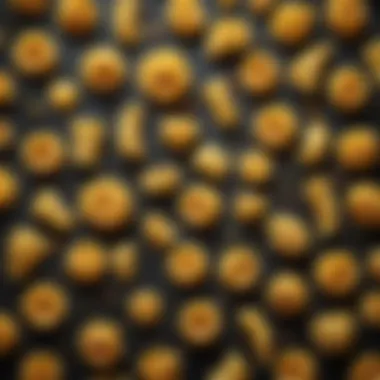Mastering Pasta with a Hand Crank Maker


Intro
In the landscape of culinary tools, the hand crank pasta maker stands as a significant instrument that bridges tradition and craftsmanship. This device, often overlooked in the age of electric gadgets, embodies a more artisanal approach to pasta making. For many, the idea of creating pasta by hand evokes a sense of nostalgia, connecting home cooks and professional chefs alike to the roots of Italian cuisine.
With a hand crank pasta maker, one can create various types of pasta that range from delicate fettuccine to robust lasagna sheets. This section intends to present a thorough understanding of the hand crank pasta maker, diving into how it works, its benefits, and maintenance tips that could prolong its life. By embracing this traditional method, you're not just making a meal; you're crafting an experience that enhances your appreciation for food.
Let's start by discussing the core aspects of pasta-making that can be explored with this tool. Whether you're a seasoned chef or a casual cook looking to experiment, delving into the nuances of pasta can elevate your culinary repertoire and offer endless opportunities for creativity in the kitchen.
Prelude to Hand Crank Pasta Makers
In a world dominated by rapid culinary advancements, the hand crank pasta maker stands as a testament to the simplicity and authenticity of food preparation. This simple device offers both novice cooks and seasoned chefs a pathway to create rich, flavorful pasta straight from scratch. Using a hand crank pasta maker can effortlessly elevate one's cooking game and is integral to understanding pasta's true essence.
Importance of Freshly Made Pasta
Freshly made pasta isn’t just a meal; it’s an experience, a fusion of textures and flavors that dried varieties simply can’t replicate. When you craft your own pasta, you gain control over every aspect, from the base ingredients to the final shape. The taste and texture take on a unique quality, which often brings the warmth of homage to family kitchens from generations past.
Notably, homemade pasta has a tender chewiness that can be tailored to suit your preferences. Choosing to make pasta by hand also allows for endless variations in flavor, allowing you to infuse ingredients like herbs or spices into the dough itself. Just picture a rich basil-studded fettuccine!
Furthermore, making pasta from scratch can be a way to connect with food traditions from different cultures. Italians, for instance, have shared their craft for generations, and joining in on this ritual connects you to a broader community of food lovers. In a nutshell, the process of rolling and cutting the dough can be just as fulfilling as the meal itself.
Historical Context of Pasta Making
Diving into pasta's history reveals a rich tapestry of culinary practices. The origins of pasta can be found nestled in ancient civilizations, where grain-based recipes evolved over centuries. Although modern pasta is widely recognized as an Italian staple, its roots can actually be traced back to Asia, where different forms of noodle use emerged much earlier.
By the 8th century, the Arabs were making a dry form of pasta called "itriyya", which could be stored for long periods - a precursor to modern pasta. The arrival of pasta in Italy further allowed it to flourish, transforming into the dish we know today. As regional variations began sprouting up across Italy, pasta evolved into various shapes and styles, marrying local ingredients and preferences with traditional techniques.
This historical insight not only sheds light on the cultural significance of pasta but also underscores the artistry of hand crafting it. The use of hand crank pasta makers represents not just a method of preparation, but a conscious decision to reconnect with culinary history - to appreciate the lineage of flavors and techniques that have shaped this beloved food.
By understanding the significance of freshly made pasta and its storied past, we prepare ourselves to delve deeper into the mechanics, benefits, and techniques associated with hand crank pasta makers.
Understanding the Mechanism of Hand Crank Pasta Makers
When it comes to hand crank pasta makers, understanding how they work is crucial for anyone aspiring to create the perfect dough. It's like trying to write a novel without knowing the alphabet; you simply can’t get anywhere. Beyond simply rolling out pasta, this mechanism unlocks the possibilities of texture, thickness, and creativity in your culinary journey. By grasping the intricate details of this device, cooks can achieve a deeper connection with their food—turning a mundane task into a delightful experience, where every cranked handle is a step towards pasta perfection.
Basic Components Explained
At first glance, a hand crank pasta maker may look like a contraption straight out of history—not quite a piece of machinery, but rather a beautifully crafted tool of the culinary arts. Understanding its basic components will help demystify the entire process of pasta making.
- Frame: The sturdy base of the machine, which holds everything in place. It’s often made of steel or aluminum, designed to ensure durability and stability during use.
- Rollers: These are the heart of the pasta maker, where the magic happens. Typically, there are two rollers, and the gap between them can be adjusted, allowing you to dictate the pasta’s thickness. The beauty lies in the ability to roll the dough thinner and thinner until it’s essentially translucent.
- Crank handle: This is the part you turn to feed the dough through the rollers. The handle’s placement and ergonomics can make a world of difference—after all, you don’t want to be wrestling with a stubborn handle when you're aiming for a smooth operation.
- Cutter: Some models come equipped with a cutter attachment, which makes it easy to slice your rolled dough into specific pasta shapes, such as fettuccine or tagliatelle. This additional feature saves time without skimping on precision.
By understanding these components, the user can utilize the pasta maker more efficiently, making adjustments that suit personal preferences and requirements, thereby enhancing the overall pasta-making experience.
How the Cranking Mechanism Works
Now, let's delve into the workings of the cranking mechanism itself. At the heart of it, this is a remarkably straightforward yet ingenious design. When you turn the crank, it engages the rollers inside the machine, causing them to rotate and flatten the dough. Imagine each turn as a gentle embrace that gradually transforms the dough from a rough start into a beautifully smooth sheet.
- Initiating the Process: Once your dough is prepared, you place it between the rollers and turn the crank. The rollers pull the dough through, making it thinner as it progresses. It’s important to start with a wider setting and work your way down to thinner settings gradually. Rushing can lead to uneven pasta, which can be more of a headache than a treat.
- Adjusting Thickness: Depending on the type of pasta being made, you may want to adjust the thickness. Most hand crank pasta makers allow you to easily tweak the gap between the rollers. This adaptability is essential for various pasta shapes, as some require a firm base, while others thrive on being delicate and airy.
- Cutting the Pasta: After rolling, the dough can be cut with a simple flick of the wrist if your model has that feature. If not, a proper knife will do, but the effort is amphitheater in front of the audience—achieving a level of artistry and finesse.
In summary, understanding the cranking mechanism is vital, as it ensures that every time you sit down to a plate of fresh pasta, you can appreciate the craftsmanship that goes into making it. With practice, anyone can master this technique and elevate their dishes to a level seldom experienced with store-bought options.
"The beauty of cooking is that you can refine your skills over time, making each pasta-making session better than the last."
Adopting these insights can transform the potentially daunting task of pasta making into an engaging and rewarding endeavor. With a little patience and curiosity, you can master the art of pasta creation, finding joy and satisfaction in each handcrafted strand.
Benefits of Using a Hand Crank Pasta Maker
When delving into the world of pasta making, adopting a hand crank model can seem like a leap back in time, yet it proves to be a wise choice for serious culinary enthusiasts. Understanding the benefits of this method creates a strong foundation for elevating one's kitchen skills. The use of a hand crank pasta maker not only enhances your pasta experience but also connects you to a long-standing tradition of culinary craftsmanship. The tactile nature of this tool allows for greater mastery over the craft, ensuring that your pasta not only tastes great but also satisfies your aesthetic and textural desires.


Enhanced Control Over Thickness and Texture
One of the most significant advantages of utilizing a hand crank pasta maker lies in the control it offers. Unlike electric machines, a hand-cranked model grants the user the ability to adjust the thickness of the dough with precision. Each crank of the handle translates into tangible results, allowing you to experiment with various types of pasta. You can work the dough to your desired thinness—whether that’s for delicately rolled tagliatelle or heartier fettuccine.
The wide range of thickness settings not only allows for customized textures, but also ensures that the pasta maintains an appropriate cook consistency. You can feel the dough, make adjustments as needed, and better understand how different thicknesses affect the final dish. This process leads to a deeper appreciation for the craft of pasta making, as you witness firsthand how small changes yield different outcomes.
Self-Sufficiency in Pasta Preparation
With a hand crank pasta maker, self-sufficiency becomes a reality in the kitchen. No longer do you need to rely on pre-packaged alternatives��—which often contain preservatives and lack the bold, fresh flavors of homemade pasta. Whether it's a spur-of-the-moment dinner or a planned gathering, the ability to whip up fresh pasta at a moment's notice empowers you as a cook.
Making pasta from scratch might seem daunting, but with practice, it becomes second nature. Combining simple ingredients, such as flour and eggs, allows you to tailor your pasta to suit dietary restrictions or flavor aspirations. The knowledge that you can produce high-quality pasta any time you desire instills confidence in everyday cooking.
Therapeutic Aspects of Manual Cooking
Amidst the chaos of life, engaging in manual cooking offers a therapeutic escape. The repetitive motion of cranking the handle provides a meditative rhythm, promoting mindfulness. Focusing on the task at hand—shaping dough, rolling it out, and then cutting it into desired shapes—can be alleviating, giving you a break from the frantic pace of daily life. Many chefs who use a hand crank pasta maker find the meditative practice to be centering, drawing them away from distractions and into a state where creativity flourishes.
Furthermore, there's joy in the process itself. Working with your hands allows for a deeper connection to your food, creating a sense of accomplishment that extends beyond the final product. In an age dominated by distractions, finding solace in the ancient craft of pasta making reinforces the value of patience, skill, and simplicity in cooking.
"Cooking is an intimacy shared between the hands and the heart."
In summary, the hand crank pasta maker embodies not just a tool but an instrument of empowerment, creativity, and mindfulness in the kitchen. Its practical benefits extend to control over your ingredients, boosting self-sufficiency, and providing an avenue for therapeutic engagement. Embracing this approach to pasta making could very well change your culinary journey for the better.
Choosing the Right Hand Crank Pasta Maker
When it comes to crafting perfect pasta at home, selecting the right hand crank pasta maker can be a game-changer. With a cornucopia of models and features on the market, finding the ideal one that caters to individual needs is paramount. Not all pasta makers are created equal; certain characteristics can mean the difference between a joyful kitchen experience and one that feels like an uphill battle.
Whether you're new to pasta-making or an old pro, grasping the nuances of various models makes the process smoother and more gratifying.
Key Features to Consider
Before pulling out your wallet, it’s essential to identify key features that will serve you best:
- Material Quality: Look for pasta makers constructed from stainless steel or durable plastic, as these materials ensure longevity and sturdiness.
- Adjustable Rollers: A pasta maker with adjustable rollers gives you the flexibility to create pasta of varied thickness. This is vital for different recipes and personal preferences.
- Width of the Rollers: Wider rollers can handle larger sheets of pasta, which is especially significant for lasagna and stuffed pasta shapes.
- Ease of Use: Consider a model with a simple cranking mechanism. The last thing you want is to wrestle with a machine when you should be enjoying the process.
- Cleaning and Maintenance: Opt for pasta makers that are easy to disassemble. Cleaning should not turn into a tedious task. A non-stick surface can be a big-helper here.
- Versatility: Some models come with attachments for cutting different types of pasta shapes. If you’re venturing beyond the standard fare, this could be a worthwhile investment.
"The best kitchen tool is one that not only performs but also inspires creativity."
In essence, understanding these key features can make the art of pasta-making more accessible and enjoyable.
Comparative Review of Popular Models
While the market is flooded with various options, a few models have garnered attention for their outstanding performance and build quality. Here’s a look at some popular contenders that might catch your eye:
- Marcato Atlas 150: This model stands out with its durable construction and exceptional versatility. It boasts 9 thickness settings, allowing for precise adjustments to suit your specific pasta needs. Additionally, it's compatible with numerous attachments.
- Norpro Pasta Maker: Ideal for those on a tighter budget, the Norpro manages to deliver quality pasta without breaking the bank. It’s straightforward to use with solid stainless steel rollers, though it offers fewer thickness adjustments.
- Imperia Pasta Maker: This classic model has been a favorite for decades. Its sturdy build and ease of use make it a reliable choice. It’s also equipped with several attachments for different pasta shapes, providing great versatility.
- Philips Pasta Maker: While it’s electric, it deserves mention for those who value speed and ease. It automates much of the process but might lack the traditional hands-on experience these crank models offer.
- KitchenAid Pasta Roller Attachment: This is perfect for those who already own a KitchenAid stand mixer. It attaches seamlessly and offers easy operation with good performance for rolling out sheets.
Comparing these models highlights the variety of options available and encourages selecting one that aligns with your cooking style and frequency. With the right choice, the adventure into the world of homemade pasta becomes not just a possibility but an exciting culinary journey.
Mastering the Techniques of Pasta Making
Mastering the art of pasta making is like finding the key to an ancient vault filled with the treasures of culinary delights. Through the careful manipulation of simple ingredients and the skilled use of a hand crank pasta maker, anyone can create a gastronomical experience that speaks to both tradition and personal creativity. This section sheds light on various techniques essential for producing exceptional pasta, offering both novice and seasoned chefs a guiding hand.
Preparing the Dough: Ingredients and Ratios
Creating dough is the foundation for successful pasta making. The balance of ingredients can greatly influence the texture, flavor, and ultimately, the satisfaction derived from the final dish.
The classic Italian dough is typically made using two primary ingredients: flour and eggs. For every cup of flour, one can use around one large egg, plus an additional yolk for richness, the exact ratio can vary. Here are a few things to consider:
- Type of Flour: Different flours yield different results. For instance, using Italian 00 flour can produce a silkier texture compared to all-purpose flour.
- Moisture Balance: Depending on the humidity, you may need to adjust the amount of egg or add a little water to achieve the right consistency. The dough should be soft yet not sticky.
- Resting Time: Allowing the dough to rest for at least 30 minutes is key. This step lets the gluten relax, ensuring the pasta doesn't spring back during rolling.


For those looking to experiment, consider incorporating different flavors into your dough using spinach, beetroot, or squid ink, which can lend a unique character to your pasta.
Step-by-Step Pasta Rolling Process
Once the dough is properly rested, it’s time to roll it out. This is where the hand crank pasta maker shines. Here’s a step-by-step guide:
- Dividing the Dough: Cut the dough into smaller pieces, roughly the size of a fist, to make it manageable.
- Flattening the Dough: Before cranking, flatten each piece gently with your hands or a rolling pin. This helps the machine take it in smoothly without jamming.
- Setting the Thickness: Start at the widest setting on the pasta maker and feed the dough through. Gradually decrease the thickness setting, feeding the dough through each time until you reach your desired thinness.
- Dusting with Flour: Throughout this process, keep a little flour handy. Dust the dough lightly to prevent sticking, but avoid overdoing it as too much flour can affect texture.
- Observation and Adaptation: Sometimes the process isn’t straightforward. Check the dough as you go; if it tears easily, it may need more resting time.
"Good pasta is made with the hands and the heart, guided by patience, intuition, and a little bit of love."
Cutting and Shaping Different Pasta Types
Once you have rolled out your pasta sheets, the fun begins with cutting and shaping. This is where one’s creativity can shine through.
- Tagliatelle: Roll your sheets into a loose cylinder and use a sharp knife to cut them into strips approximately 1/4 inch wide. Unravel the strips and lay them out to dry a bit.
- Ravioli: Use one sheet as the base, and scoop dollops of your filling of choice. Place another sheet over the first, pressing out air and sealing the edges with a bit of water.
- Farfalle: Cut the rolled sheets into rectangles, then pinch them in the center to form a bow shape.
Experimentation is key here. Just as every region of Italy has its own pasta shapes, you can invent your own. Shape, cut, and rearrange pasta into your masterwork.
Through these fundamental techniques, the home cook can transform basic ingredients into intricate pasta creations that capture not just flavors but also a sense of achievement and heritage.
Exploring Various Pasta Varieties
In the realm of hand-crank pasta making, the exploration of various pasta varieties stands out like a gem. The creative possibilities are vast and exciting. Understanding different shapes and styles of pasta not only broadens your culinary skills but also infuses each meal with a unique character. Each kind of pasta has its own personality, which pairs beautifully with different sauces and ingredients. This section dives into the importance of experimenting with various pasta types while utilizing the hand-crank tool, enriching your dining experience and connecting to culinary traditions.
Classic Italian Shapes: A Detailed Guide
Classic Italian pasta shapes are as diverse as the regions they come from. Shapes like fettuccine, tagliatelle, and pappardelle invite different sauces, making your dishes feel authentic and engaging. For example,
- Fettuccine: A flat noodle that works well with cream sauces, like Alfredo.
- Penne: A tubular shape that catches sauces inside, perfect for hearty ragu.
- Lasagna: Flat sheets that can hold many layers of deliciousness, from cheesy to veggie-packed.
Let's not forget about spaghetti! It’s a staple that can be paired with lighter sauces like pomodoro or made into a classic spaghetti and meatballs. These shapes don't just look good on the plate; they also tell a story—a tale of years spent perfecting regional recipes and techniques in Italian kitchens.
To make these classic shapes using a hand-crank pasta maker, start with the dough at the right thickness. Usually, you would roll until it’s around 1-2 mm thick, varying as per the type of pasta. Then, utilize the machine’s cutting attachment to achieve the desired shapes. It’s a tactile adventure that engages not just the hands, but the heart.
Regional Pasta Specialties Worth Trying
The world of pasta is also punctuated by regional specialties, each reflecting the culture and ingredients of its area. Exploring these unique offerings brings a touch of authenticity to home-cooked meals. Here are a few standout varieties worthy of our attention:
- Orecchiette: Originating from Puglia, these little "ears" are wonderful when combined with broccoli rabe.
- Cavatelli: Often found in southern Italy, they resemble tiny shells and are excellent for capturing sauce.
- Strozzapreti: A twisted, hand-rolled pasta from Emilia-Romagna, they pair well with hearty meats.
When you explore regional varieties like these, you get to savor a piece of the world. Crafting them with a hand-crank pasta maker not only enhances your skills but also connects you to traditions passed down through generations.
"In the kitchen, we craft not only meals, but also stories and traditions, each pasta shape a piece of our shared history."
Incorporating these diverse pasta varieties into your cooking repertoire can elevate your dishes, providing them with an artisanal touch. Whether it’s a special gathering or a simple family dinner, serving hand-made pasta adds a layer of thoughtfulness that many store-bought options simply can’t match.
Integrating Hand-Cranked Pasta into Contemporary Cuisine
The art of making pasta by hand brings an undeniable charm to the kitchen. As culinary enthusiasts strive to elevate their cooking game, integrating homemade pasta into modern cuisine becomes a gateway to exploring rich flavors and textures. Hand-cranked pasta makers provide the canvas, transforming simple ingredients into a delightful dish. This section will delve into how hand-cranked pasta fits into today's culinary landscape, the myriad benefits it offers, and important elements to consider when incorporating it into contemporary cooking.
Pairing Pasta with Sauces: Traditional vs. Modern
When it comes to pasta, the sauce is what truly brings each dish to life. Traditional Italian sauces, like marinara or alfredo, have stood the test of time, interpreting the lush flavors of Italy itself. Pairing these classic sauces with hand-cranked pasta results in a beautiful symphony of texture and taste. Think of fresh fettuccine enveloped in rich, creamy alfredo, or delicate ravioli, bursting at the seams with a savory filling, served with a vibrant basil pesto.
On the other hand, modern cuisine encourages experimentation. With culinary boundaries being pushed, home cooks can get creative merging global flavors. For instance, try pairing hand-made linguine with a spicy Thai chili cream sauce for an unexpected twist. Maybe incorporate a Japanese miso glaze over freshly crafted udon noodles. The versatility of hand-cranked pasta allows cooks to explore these fusion dishes while honoring its traditional roots.
Here are a few ideas to consider:


- Classic Pairings:
- Modern Twists:
- Fettuccine with Alfredo
- Spaghetti with Marinara
- Tagliatelle with Mole Sauce
- Pappardelle tossed in Red Curry Sauce
"The true essence of pasta making lies not only in its creation but in the art of pairing it with sauces that sing harmoniously."
Incorporating Seasonal Ingredients
One of the beauties of hand-cranked pasta is how it complements seasonal ingredients. Freshly made pasta can serve as the ideal backdrop for the vibrant produce each season brings. Embracing seasonal ingredients not only enhances flavor but also aligns with the philosophy of sustainability in cooking.
In spring, consider crafting a light rabbit ragu, featuring fresh peas and asparagus tossed with pappardelle. Summer could inspire a zesty sauce made from ripe tomatoes, basil, and mozzarella, served over a delicate angel hair pasta. Come fall, think of a hearty pumpkin and sage filling for ravioli, beautifully complemented with nutty brown butter.
In winter, robust greens like kale or swiss chard can shine when paired with tagliatelle tossed in a simple olive oil and garlic sauce. The adaptability of hand-cranked pasta fosters culinary creativity, allowing the home cook to weave in elements of the season.
Some Practical Tips to Incorporate Seasonal Ingredients:
- Visit Local Farmers’ Markets: Engage with local farmers for the freshest, in-season produce.
- Experiment with Textures: Mixing crunchy nuts or seeds can add depth.
- Play with Colors: Brightly colored vegetables can lift the visual appeal of a dish.
Alongside the nuanced flavors that hand-cranked pasta brings, integrating it with season’s offerings not only transforms a meal but revives a connection to nature that enriches the dining experience.
Maintenance and Care for Your Hand Crank Pasta Maker
Taking care of your hand crank pasta maker is essential to ensure it stays in tip-top shape for years to come. This aspect of ownership often gets overlooked, but it plays a significant role in the longevity of the device and the quality of the pasta you produce. Like any kitchen tool, consistent maintenance promotes both functionality and hygiene, so diving into this topic is vital for anyone passionate about pasta.
Cleaning After Use
Cleaning your pasta maker after each use is a non-negotiable step. Regardless of how homemade pasta tends to cling onto everything, leaving residues of flour and dough can lead to mold and other unpleasant surprises. Here’s a simple guide to help you clean your pasta maker effectively:
- Immediate Attention: Always clean your machine soon after you finish your pasta session. Dry dough is much harder to remove later on.
- Brushing: Take a soft brush or even a simple pastry brush and gently sweep away any remaining flour or dough particles. This step helps maintain its performance.
- Damp Cloth: Wipe down the surfaces of the machine with a damp cloth. However, avoid getting water into the gears. Think of it as giving your machine a gentle shower, but not a swim.
- Disassemble: If your model allows for it, disassemble parts that come into contact with dough for a more thorough cleaning. Remember to note the order of parts for reassembly!
- Dry Completely: Always ensure that every component is thoroughly dried before putting it away. Moisture can lead to rust, and nobody wants that in their kitchen!
Taking these small steps will not only prolong the life of your pasta maker but also enhance the purity of your ingredients in future dishes.
Advice on Long-Term Preservation
Longevity is key when investing in a hand crank pasta maker. Here are a few tips to ensure it serves you well for many delightful pasta-making endeavors:
- Storage: When storing the pasta maker, keep it in a cool, dry place. Direct sunlight and humidity are not friends of your kitchen equipment. Perhaps a cupboard or a dedicated baking drawer will do the trick.
- Avoid Overexertion: Use your pasta maker within its intended limits. For instance, avoid cranking too forcefully, as this can lead to mechanical strain.
- Regular Checks: Periodically check for any loose pieces or wear and tear. Address small issues before they morph into bigger problems. Just like a good relationship, communication with your tools is key.
- Use It Often: Last but not least, utilize your pasta maker regularly. Ironically, the best way to keep it in great shape is to use it. Just like an antique, it flourishes with love and attention.
Adhering to these principles ensures not only the longevity of your hand crank pasta maker but also its enduring excellence in crafting the perfect pasta. Your commitment to maintenance reveals a deep appreciation for culinary art and elevates your entire cooking experience.
Finale: The Artistry of Handmade Pasta
Handmade pasta is not just a culinary task; it’s a form of art that connects us to traditions, cultures, and flavors. With the hand crank pasta maker in hand, one can explore and express creativity that is rarely accessed in modern, mass-produced alternatives. As we wrap up this exploration into the world of hand-cranked pasta, the significance of embracing this method becomes starkly clear. It’s about more than just making food; it’s creating an experience that can be savored by all.
Embracing the Craft
Engaging with the craft of pasta making allows one to experience the beauty of culinary craftsmanship. There’s a magical quality that unfolds as the dough is transformed under one's hands—feeling the texture, adjusting moisture, and witnessing each roll unveil thin sheets of pasta ready to be cut into shapes. This tactile engagement fosters an intimate relationship between the creator and what is created.
This act can be meditative, providing a break from our busy lives. The rhythmic turning of the crank, the aroma of flour and eggs mixing, all meld into a sense of peace that transforms an everyday meal into a celebration. For those who might feel intimidated, remember: nobody gets it right all the time. Errors are just stepping stones; every flattened sheet or uneven cut teaches something new.
Moreover, this craft isn’t confined to traditional forms. Food enthusiasts are no longer limited to the familiar spaghetti or fettuccine. With creativity and experimentation, one might create spinach-infused ravioli, vibrant beet pappardelle, or even play around with gluten-free options. The art of making pasta by hand is all about harnessing this freedom, leading to a never-ending creative journey.
Continuing the Tradition in Modern Kitchens
While modern kitchens are frequently filled with gadgets that promise speed and convenience, the art of hand-cranked pasta offers a unique opportunity to preserve culinary traditions. It bridges the gap between generations, allowing families to pass recipes and techniques down the line, embedding stories and memories into each batch of pasta.
Some may argue that technology and innovation should take precedence in the kitchen. However, consider the value of tradition; hand-made pasta represents a touch of authenticity that automated processes often lack. It encourages conversations around the table, where recipes are shared, laughter is exchanged, and bonds are strengthened. Every plate of handmade pasta recalls the efforts and joy involved in its crafting.
Additionally, the resurgence of local and sustainable eating patterns emphasizes the importance of knowing where our food comes from. By employing a hand crank pasta maker, one is actively choosing to engage with ingredients, support local farmers, and reduce reliance on industrial processes. Each flavorful bite tells a story of diligence and respect for craft.
In closing, the journey of hand-cranked pasta making teaches invaluable lessons about patience, precision, and passion. Pastas made by hand are more than just food; they celebrate our shared heritage and enable us to explore modern culinary landscapes while remaining grounded in tradition. It’s a beautiful dance between past and present, one that invites everyone to join in.







